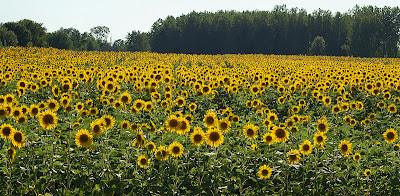Black Locust savanna
The savannas in the prairie region mainly consist of Bur Oak, Quercus macrocarpa, but here at the Iron Bridge Prairie at Midewin it is a small savanna or rather open woodland of Black Locust, Robinia pseudoacasia.
The Black Locust is a lovely tree with ornamental branches and a open, loose crown with a scanty leafage that allow some light to pass to the ground and permit a rich understory of grasses and forbs.
The Iron Bridge Prairie at Midewin is fairly new. The restoration of the prairie that once existed here began as late as in 2009. This text is partly taken from an information sign at the prairie. Thanks to many years of cultivating rowcrops as corn and soybeans the soil was rather free from weeds.
Two years ago Midewin staff and volunteers spread 1000 pounds of prairie seeds from 98 different species. This was followed by the planting of 5000 prairie plant plugs.
The first plants to flower are the pioneer plants with rapid growth as Yellow Coneflower, Ratibida pinnata and Wild Bergamot, Monarda fistulosa. They benefit from disturbance and have their best development some few years afterwards.
It will take several years for the majority of the prairie plants to establish their root systems and grow in numbers to out-compete invasive, weedy species.
Like a yellow lake of Coneflowers
Monarda and Ratibida are pioneer members of the prairie ecosystem
Monarda fistulosa, Ratibida pinnata and Coreopsis tripterris
The path through the Black Locust Savanna






























